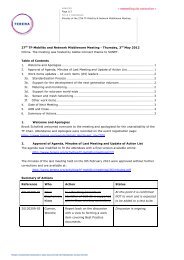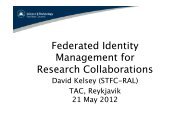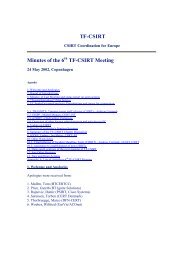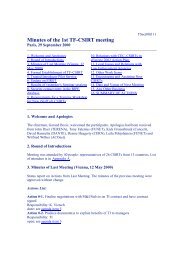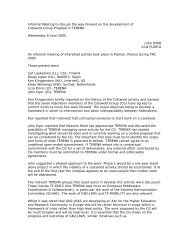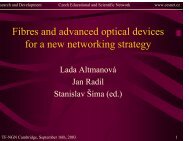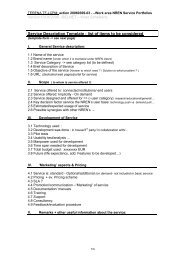Good Things Come in Small Cubes Good Things Come in Small ...
Good Things Come in Small Cubes Good Things Come in Small ...
Good Things Come in Small Cubes Good Things Come in Small ...
Create successful ePaper yourself
Turn your PDF publications into a flip-book with our unique Google optimized e-Paper software.
Page 1<br />
<strong>Good</strong> <strong>Th<strong>in</strong>gs</strong><br />
<strong>Come</strong> <strong>in</strong> <strong>Small</strong> <strong>Cubes</strong><br />
TERENA NGN Workshop:<br />
Deploy<strong>in</strong>g CWDM & DWDM <strong>in</strong> Research<br />
and Education Networks<br />
Sven Krüger (Dir. Sales & Market<strong>in</strong>g)
Page 2<br />
Cube Optics: Access Solution Provider<br />
Headquartered <strong>in</strong> Ma<strong>in</strong>z (GER) – Presence <strong>in</strong> US, CA, IL, ES, FR,<br />
SE, NL, NR, IT, UK, JP, SL, AT, MX, PR, PT,…<br />
Only EU fiber-optical component & WDM system manufacturer<br />
Access Solutions for OEMs and Network Operators
Page 3<br />
Content: Deploy<strong>in</strong>g CWDM & DWDM <strong>in</strong> REN<br />
Optical transport basics (s<strong>in</strong>gle / multi mode fibers, <strong>in</strong>sertion loss,<br />
dispersion)<br />
Wavelength Division Multiplex<strong>in</strong>g:<br />
Set-up / Function<br />
DWDM, CWDM, WWDM and how this relates to applications and<br />
match<strong>in</strong>g transceivers<br />
Passive WDM Networks<br />
Active vs. Passive WDM Systems<br />
Pr<strong>in</strong>cipal architectures
Page 4<br />
Structure of an optical Fiber<br />
From the center outwards:<br />
Fiber core (glass), diameter 9 ... 62,5µm<br />
Gladd<strong>in</strong>g (glass, lower refractive <strong>in</strong>dex than the core), diameter 125µm<br />
Coat<strong>in</strong>g (acrylate), diameter 250µm<br />
Jacket (loose tube or tight buffer), diameter 900µm<br />
Outer jacket (diameter typically 2-3mm)<br />
Transport of light <strong>in</strong> the core by total reflection at gladd<strong>in</strong>g
Page 5<br />
Fiber types<br />
Multi Mode Fibers:<br />
Core diameter: 50µm (EU) / 62.5µm (US)<br />
Advantages: Lowest cost transceivers, simple connections<br />
Disadvantages: Short reach (ca. 500m) due to bandwidth-length-product<br />
Applications: LAN, Equipment <strong>in</strong>terconnection<br />
S<strong>in</strong>gle Mode Fiber:<br />
Fiber core: Diameter 8,2µm<br />
Standard fiber: SMF-28 (Manufacturer: Corn<strong>in</strong>g)<br />
ITU Standard: G.652 (A, B, C, D) – Impact on Dispersion<br />
Application: From LAN to WAN<br />
Specialty Fibers:<br />
E.g.dispersion shifted fiber (Dispersion m<strong>in</strong>. @1550nm <strong>in</strong>stead 1310nm)
Page 6<br />
Transport Limit<strong>in</strong>g Factor: Insertion loss<br />
Fiber Loss: dependent on length, lambda and fiber type (e.g. Corn<strong>in</strong>g SMF-28)<br />
(typ. 0.25dB/km @ 1550nm<br />
0.35dB/km @ 1310nm)<br />
Passive optical component loss (multiplexers, couplers, ...): component specific.<br />
Optical connectors also <strong>in</strong>troduce loss (dust is #1 on troubleshoot<strong>in</strong>g)<br />
Thumb rule: Transport up to 2.5G is loss limited, 10G+ is dispersion limited
Page 7<br />
Transport Limit<strong>in</strong>g Factor: Fiber Dispersion<br />
Chromatic Dispersion: signals of different wavelengths propagate at different<br />
speed<br />
Laser l<strong>in</strong>e width is f<strong>in</strong>ite, so the dispersion lowers signal quality<br />
The dispersion therefore limits the transmission distance<br />
Impact of dispersion depends on data rate (no role at Gig E, important at<br />
10Gig E)<br />
Dispersion [ps/nm/km]<br />
25<br />
20<br />
15<br />
10<br />
5<br />
0<br />
-5<br />
Dispersion of standard SMF-28 fiber (Corn<strong>in</strong>g)<br />
-10<br />
1250 1300 1350 1400 1450 1500 1550 1600 1650<br />
Wavelength [nm]
Page 8<br />
Optical Multiplex<strong>in</strong>g: Pr<strong>in</strong>cipal<br />
Mux<br />
Transmission Fiber<br />
Demux<br />
Fused couplers can be used to mux => 50% loss per comb<strong>in</strong>ation!<br />
λ-sensitive fused couplers (WDM Couplers) can be used as well as<br />
Demux => Very low Isolation => Cross Talk => High Bit Error Rate<br />
Comb<strong>in</strong><strong>in</strong>g (Mux) and Separation (Demux) of several channels /<br />
wavelengths via <strong>in</strong>terference filters (TFF technology for C/DWDM)<br />
Constructive / destructive <strong>in</strong>terferences enable, “loss-free” mux<strong>in</strong>g and<br />
demux<strong>in</strong>g
Page 9<br />
CUBO’s Mux Set-up<br />
Each TFF transmits 1 channel and<br />
reflects the rest (Isolation)<br />
Cascaded TFF filters. Beam<br />
directions are reversible (bi-di use).<br />
Beam shap<strong>in</strong>g<br />
Passive fiber alignment
Page 10<br />
Insertion Loss [dB] Example Spectrum: 8 ch. CWDM (1470-1610nm)<br />
0<br />
-10<br />
-20<br />
-30<br />
-40<br />
-50<br />
1451 1471 1491 1511 1531 1551 1571 1591 1611 1631<br />
Wavelength [nm]
Page 11<br />
Channel Grid and Muxes<br />
Special Bandfilters: EXP, Upgrade, etc.<br />
CWDM „blue“ upgrade<br />
DWDM (Dense Wavelength Division Multiplex):<br />
>100 channels / 200GHz, 100GHz, 50GHz grids /<br />
Spac<strong>in</strong>g 1.6nm, 0.8nm, 0.4nm<br />
H 2 O<br />
EXP: „gey“<br />
1550nm SFPs<br />
CWDM (Coarse Wavelength Division Multiplex): 18 channels<br />
(1271, 1291, …, 1611nm / Spac<strong>in</strong>g: 20nm / Channel width: 13nm<br />
WWDM (Wide Wavelength Division Multiplex): 2 channels<br />
1310nm (1260-<br />
1550nm (1460-1620nm)<br />
1360nm)<br />
1270<br />
1290<br />
1310<br />
1330<br />
1350<br />
1370<br />
1390<br />
1410<br />
1430<br />
1450<br />
1470<br />
1490<br />
1510<br />
1530<br />
1550<br />
1570<br />
1590<br />
1610
Page 12<br />
Transceivers: “Grey vs Colored”<br />
„Grey“ Transceivers:<br />
VCSEL lasers (850nm, MM),<br />
Fabry Perot lasers (1310nm / 1550nm)<br />
(DFB laser for >10G &/ WAN)<br />
Easy and simple to manufacture => Very low-cost<br />
„Colored“ Transeivers:<br />
Only DFB lasers ( option for multiple-l bi-di transmission)<br />
Only DWDM may be amplified, if C or DWDM is best depends on many<br />
factors (reach, channel count, data rate, protocol...)
Page 13<br />
How far do I get?<br />
Reach is limited by loss /& dispersion<br />
Reach specifications refer to best conditions without additional losses<br />
(splices, connectors, muxes) and optimum dispersion characteristics (so<br />
reach is only a h<strong>in</strong>t)<br />
Different reach results from different power budgets. These are achieved by<br />
comb<strong>in</strong><strong>in</strong>g higher / less sensitive detectors (PIN vs. APD) with different laser<br />
diods<br />
Power Buget = M<strong>in</strong> Tx – M<strong>in</strong> Rx<br />
The reach is then given by:<br />
L<strong>in</strong>k Loss = Sum of ALL Losses + 3dB < Transceiver Power Budget<br />
Dispersion leads to a loss penalty, reduc<strong>in</strong>g the effective power budget of<br />
the transceiver
Page 14<br />
Active Vs Passive Transport<br />
Active Transport System:<br />
Conversion from client (“grey”) to l<strong>in</strong>e (colored)<br />
signals by transponder cards<br />
S<strong>in</strong>ce be<strong>in</strong>g “active” a chassis with red. power<br />
and management (SNMP) is needed<br />
Flexible but complex<br />
Passive WDM System:<br />
No conversion, transport transceivers are<br />
plugged straight <strong>in</strong>to term<strong>in</strong>al equipment<br />
Less active elements => higher reliability<br />
Transceivers are managed by term<strong>in</strong>al<br />
equipment (Switch, DSLAM, etc.)
Page 15<br />
Application: Dark Fiber Access Networks<br />
Optimiz<strong>in</strong>g Dark Fiber Lease by multiple use through passive Muxes
Page 16<br />
Two different multiplexer types:<br />
4 ch.<br />
2 Pr<strong>in</strong>cipal Designs: MUX vs OADM<br />
Demux<br />
Mux&Demux Add&Drop (OADM)<br />
Mux<br />
4 ch.<br />
All channels are term<strong>in</strong>ated, Some channels term<strong>in</strong>ated,<br />
No channel passed through Rest passed through (optical<br />
transparent)<br />
…enable two network architecture variants:<br />
Shar<strong>in</strong>g / Dedicat<strong>in</strong>g Traffic <strong>in</strong> R<strong>in</strong>gs, see next slides<br />
4 ch. 4 ch.<br />
OADM<br />
Drop<br />
ch. x,y<br />
Add<br />
ch. x,y
Page 17<br />
Dedicat<strong>in</strong>g Channels: OADM based R<strong>in</strong>gs<br />
Example 4 nodes <strong>in</strong> redundant r<strong>in</strong>g<br />
architecture<br />
Specific OADM for each node dedicates 1<br />
channel to each node<br />
No need for L2/L3 switch<strong>in</strong>g, “optical<br />
rout<strong>in</strong>g” with direct hubs&spokes structure<br />
on L2<br />
Low qty of transceivers (CAPEX)<br />
Higher variety of mux parts<br />
Less flexible than Mux&Demux<br />
Number of nodes depends on given<br />
channels<br />
Challeng<strong>in</strong>g for large r<strong>in</strong>gs (L<strong>in</strong>k loss<br />
limited)<br />
λ #2<br />
λ #1<br />
4 8 ch<br />
POP<br />
up to 8 nodes<br />
1 Gbe per node<br />
λ #3 #n<br />
λ #4 #8
Page 18<br />
Dedicat<strong>in</strong>g Channels: OADM based R<strong>in</strong>gs<br />
Layer 1: Optical Layer view<br />
Layer 2: Ethernet view
Page 19<br />
Shar<strong>in</strong>g traffic: Mux&Demux based R<strong>in</strong>gs<br />
Example 4 nodes <strong>in</strong> redundant r<strong>in</strong>g<br />
architecture<br />
Same Mux&Demux <strong>in</strong> all locations, all<br />
channels are shared between all nodes<br />
Need for L2/L3 switch<strong>in</strong>g (spann<strong>in</strong>g tree<br />
protocol)<br />
Higher flexibility than OADM<br />
Easier design and provision<strong>in</strong>g than<br />
OADM designs, not loss limited<br />
Higher qty of transceivers (CAPEX)<br />
Number of nodes <strong>in</strong>dependent on given<br />
channels<br />
λ #1-4<br />
λ #1-4<br />
λ #1-4<br />
N nodes<br />
4 Gbe per r<strong>in</strong>g<br />
λ #1-4<br />
λ #1-4
Page 20<br />
Shar<strong>in</strong>g traffic: Mux&Demux based R<strong>in</strong>gs<br />
Layer 2: Ethernet view<br />
Ethernet<br />
switch(es)<br />
with up to 8<br />
trunked<br />
CWDM<br />
GBICs/SFPs
Page 21<br />
Outlook 100 G<br />
Higher data rates most likely only be achieved by multi-λ transceivers<br />
ITU HSSG is analys<strong>in</strong>g options and will make standard suggestions<br />
In discussion today: 4 x 25G versus 10x 10G<br />
Both as CWDM or DWDM<br />
Standards expected for 2010, pre-standard products for 2009<br />
CUBO’s multi-λ ROSA
Page 22<br />
Thank you!<br />
We look forward to provide<br />
you with further <strong>in</strong>formation.<br />
Contact:<br />
Sven Krüger<br />
+49-6131-69851-15<br />
krueger @cubeoptics.com<br />
www.cubeoptics.com



